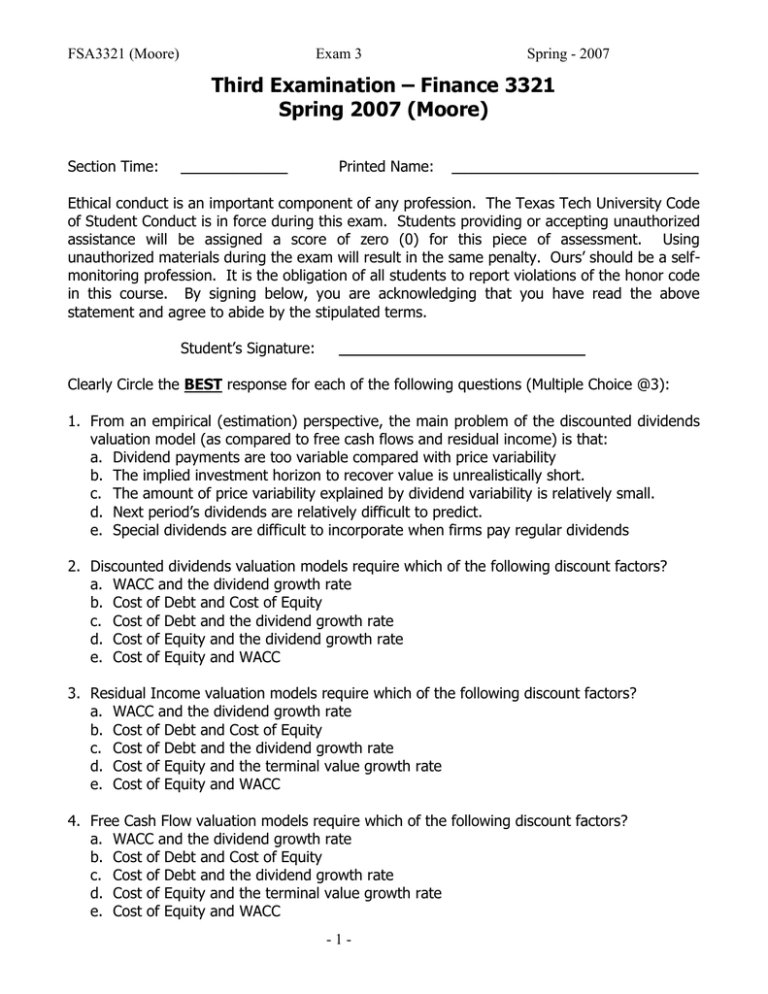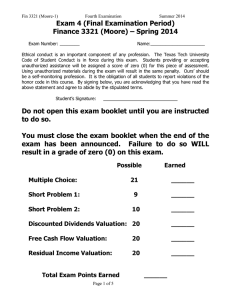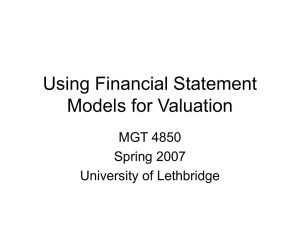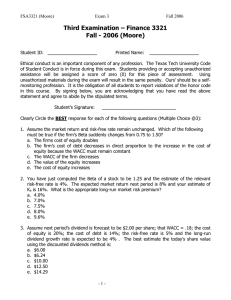Third Examination – Finance 3321 Spring 2007 (Moore)
advertisement

FSA3321 (Moore) Exam 3 Spring - 2007 Third Examination – Finance 3321 Spring 2007 (Moore) Section Time: _____________ Printed Name: ______________________________ Ethical conduct is an important component of any profession. The Texas Tech University Code of Student Conduct is in force during this exam. Students providing or accepting unauthorized assistance will be assigned a score of zero (0) for this piece of assessment. Using unauthorized materials during the exam will result in the same penalty. Ours’ should be a selfmonitoring profession. It is the obligation of all students to report violations of the honor code in this course. By signing below, you are acknowledging that you have read the above statement and agree to abide by the stipulated terms. Student’s Signature: ______________________________ Clearly Circle the BEST response for each of the following questions (Multiple Choice @3): 1. From an empirical (estimation) perspective, the main problem of the discounted dividends valuation model (as compared to free cash flows and residual income) is that: a. Dividend payments are too variable compared with price variability b. The implied investment horizon to recover value is unrealistically short. c. The amount of price variability explained by dividend variability is relatively small. d. Next period’s dividends are relatively difficult to predict. e. Special dividends are difficult to incorporate when firms pay regular dividends 2. Discounted dividends valuation models require which of the following discount factors? a. WACC and the dividend growth rate b. Cost of Debt and Cost of Equity c. Cost of Debt and the dividend growth rate d. Cost of Equity and the dividend growth rate e. Cost of Equity and WACC 3. Residual Income valuation models require which of the following discount factors? a. WACC and the dividend growth rate b. Cost of Debt and Cost of Equity c. Cost of Debt and the dividend growth rate d. Cost of Equity and the terminal value growth rate e. Cost of Equity and WACC 4. Free Cash Flow valuation models require which of the following discount factors? a. WACC and the dividend growth rate b. Cost of Debt and Cost of Equity c. Cost of Debt and the dividend growth rate d. Cost of Equity and the terminal value growth rate e. Cost of Equity and WACC -1- FSA3321 (Moore) Exam 3 Spring - 2007 5. Assume the firm will start paying dividends in two years. The first dividend is forecast to be $2.50 per share; that WACC = 8; the cost of equity is 12%; the cost of debt is 6%; the risk-free rate is 4.5% and the long-run dividend growth rate is expected to be 4% . The best estimate the today’s share value using the discounted dividends method is: a. $20.33 b. $27.90 c. $31.25 d. $58.57 e. $62.50 6. The main benefit of the residual income valuation model (as compared to free cash flows and discounted dividends) is that: a. Dividend payments are too variable compared with price variability b. The implied investment horizon to recover value is unrealistically short. c. The price variability explained by residual income variability is relatively large. d. The valuation is more sensitive to terminal value growth rates as compared to free cash flow and dividend valuation models. e. Residual income is easier to predict than the other measures. 7. A terminal (continuation) value perpetuity cash flow that begins in 7 years is $20,000. Assuming WACC equal to 12% and an annual growth rate of 4%. What is the Time 0 value of the terminal value perpetuity component? a. $20,000 b. $126,658 c. $166,667 d. $200,000 e. $250,000 8. The present value (today) of the terminal (continuation) value cash flow that begins in 8 years is $20,000,000 assuming a WACC equal to 8%. The year 8 free cash flow (beginning of the growing perpetuity) is $1,028,295. What is the growth rate required for the continuation value term? a. 1% b. 2% c. 3% d. 4% e. 5% 9. Old Reliable Manufacturing Company's stock has a market price of $30 per share and the market’s assessment of its steady state return on equity is 20% per year. If its cost of equity capital is 10 percent and its book value is expected to grow at 5 percent per year indefinitely, what is the current book value per share? a. $3.00 b. $4.00 c. $10.00 d. $15.00 -2- FSA3321 (Moore) Exam 3 Spring - 2007 10. Old Reliable Manufacturing Company's stock has a book value of $15 per share. You have estimated its cost of equity capital to be 14% and its book value is expected to grow at 10% per year indefinitely and the steady-state ROE is 14%. Compute Old Reliable’s intrinsic share value using the long run average residual income perpetuity method? a. $15.00 b. $30.00 c. $45.00 d. $60.00 11. Old Reliable Manufacturing Company's stock has a market price of $60.00 per share and a book value of $15 per share. You have estimated its steady state ROE to be 20% per year and its cost of equity capital is 14%. What expected growth rate in book value (in perpetuity) supports the current stock price? a. 15% b. 14% c. 13% d. 12% e. 11% 12. Which of the following is true regarding the Residual Income Valuation Model. a. It is devoid of financial theory b. It has the greatest explanatory and predictive power of the models we have considered c. It links accounting valuations of free cash flows d. The terminal value perpetuity easily blows out to abnormally high values e. It has limited interpretations since it cannot be decomposed into value drivers 13. Assume you had just performed a valuation using the residual income model. You found that 25% of the value was supported by the current book value; that 35% of the value was supported by residual income forecast annual for the next 7 years and the remainder was associated with terminal value computations. What type of firm are you valuing? a. A manufacturer within a stable, mature industry b. A new restaurant chain c. An established high tech company such as MicroSoft d. A major retailer such as Wal-Mart e. A new high tech firm without many existing tangible net assets such as Google 14. You are comparing the published P/B multiple with the intrinsic P/B multiple based on your valuation of a company and they differ. Both ratios use the same earnings denominator. Which of the following is correct? a. Intrinsic P/B > Published P/B implies you believe the firm is undervalued b. Intrinsic P/E < Published P/E implies you believe the firm is undervalued c. The published P/B must be wrong d. The intrinsic P/B must be wrong e. None of the above must be true -3- FSA3321 (Moore) Exam 3 Spring - 2007 Computation of Valuation Models Section (Questions 15-18) Use the following summary financial statement information and forecasts provided by TTU Value-Metrics to answer the valuation questions in this section about Hi-Flyer Corp. All Per Share EPS DPS BVE (year end) CFFO CFFI CFFF BV Liabilities Ke Kd WACC Actual 31 Dec 2004 2.00 0.20 20.00 5.00 -3.00 -2.00 40.00 0.15 0.08 0.10 Estimated 31 Dec 2005 2.25 0.20 Estimated 31 Dec 2006 2.20 0.30 Estimated 31 Dec 2007 2.50 0.30 6.00 -2.50 -4.00 4.00 -4.00 2.00 6.00 -5.00 2.00 CFFO = Cash Flow from operating activities CFFI = Cash Flow from investing activities CFFF = Cash Flow from financing activities 15. Compute the book value of equity at the end of 2005. a. $22.05 b. $23.95 c. $26.15 d. $28.52 16. (Residual Income Valuation). Compute the normal income for 2007. a. $2.0000 b. $3.0000 c. $3.3075 d. $3.5925 17. Compute the free cash flow of Hi-Flyer’s for 2006. a. $0.00 b. $2.00 c. $4.00 d. $6.00 18. (Residual Income Valuation - sensitivity). Assume the residual income perpetuity was initially estimated to be $1.00 beginning in 2008 with a -20% growth rate. By how much will this valuation change if growth is changed to 4% (positive)? a. $7.17 lower b. $9.09 higher c. $5.98 higher d. $19.13 higher e. $29.09 higher -4- FSA3321 (Moore) Exam 3 Spring - 2007 19. You have the following per share information available. Residual Income (RI) in 2002 is $(0.42), RI in 2003 is $0.58 and Residual Income in 2004 is $1.08. Assume Ke is 10% and that dividends in 2002, 2003 and 2004 are $3.00, $0.50 and $0.60, respectively. EPS in 2002 and 2003 are $4.00 and $5.00. Compute the ending BVE per share for 2003. a. $44.20 b. $45.20 c. $48.40 d. $56.00 e. $56.35 20. EPAY is a publicly traded internet-based world-wide garage sale broker. It’s P/B = 6; Trailing P/E = 56; and Leading P/E = 34. Assuming EBAY has a cost of equity capital of 13% and that its ROE has been consistently at 14% for the past 3 years. What growth rate in book value (per year) must EBAY average in the long run in order to support its current stock price? a. 2.60% b. 5.34% c. 12.8% d. 15.4% e. 17.8% -5- FSA3321 (Moore) Exam 3 Spring - 2007 Problem 1 – Free Cash Flow Valuation (20 Points) Show all work Use the following summary financial statement information and forecasts provided by TTU Value-Metrics to answer the valuation questions in this section about Hi-Flyer Corp. Assume a Terminal value perpetuity beginning in 2008 of $8.00 that is expected to grow at 4% per year. Value the shares using the discounted free cash flow method. All Per Share EPS DPS BVE (year end) CFFO CFFI CFFF BV Liabilities Ke Kd WACC Actual 31 Dec 2004 4.50 1.10 25.00 5.00 -3.00 -2.00 20.00 0.14 0.06 0.10 Estimated 31 Dec 2005 5.25 1.50 Estimated 31 Dec 2006 6.60 1.80 Estimated 31 Dec 2007 7.80 2.00 6.00 -2.50 -4.00 9.00 -4.00 2.00 12.00 -5.00 2.00 CFFO = Cash Flow from operating activities CFFI = Cash Flow from investing activities CFFF = Cash Flow from financing activities -6- FSA3321 (Moore) Exam 3 Spring - 2007 Problem 2 – Residual Income Valuation (20 Points) Show all work Use the following summary financial statement information and forecasts provided by TTU Value-Metrics to answer the valuation questions in this section about Hi-Flyer Corp. Assume a Terminal value perpetuity beginning in 2008 of $.06 that is expected to grow at 2% per year. Value the shares using the residual income method. All Per Share EPS DPS BVE (year end) CFFO CFFI CFFF BV Liabilities Ke Kd WACC Actual 31-Dec-04 Estimated 31-Dec-05 2.5 1.1 25 5 -3 -2 20 0.14 0.06 0.1 Estimated 31-Dec-06 3.6 1.2 4.04 1.4 4.25 1.6 6 -2.5 -4 9 -4 2 12 -5 2 CFFO = Cash Flow from operating activities CFFI = Cash Flow from investing activities CFFF = Cash Flow from financing activities -7- Estimated 31-Dec-07






